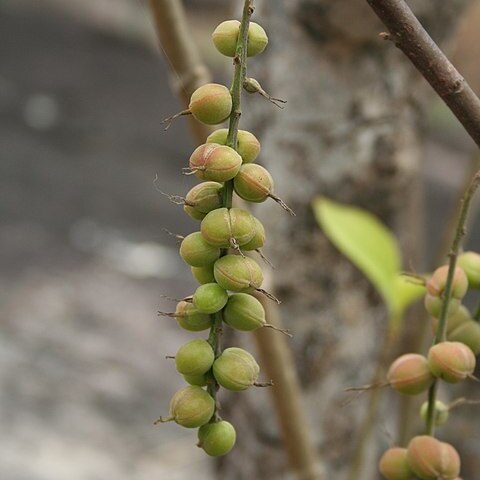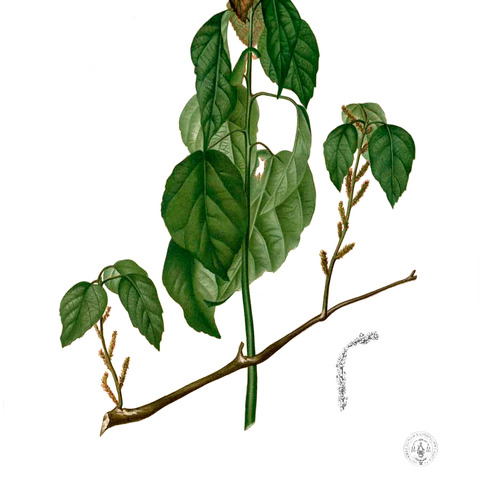Shrubs or trees, evergreen, perennial, mostly dioecious, sometimes monoecious; stems and foliage without latex. Indumentum of simple, multicellular trichomes, glandular trichomes absent, stinging trichomes absent. Stipules entire, inconspicuous, deciduous. Leaves alternate, petiolate to sessile, usually elobate, sometimes shallowly lobed, palmi-or penninerved, crenate to serrate, glands absent. Inflorescence terminal or axillary, spicate or paniculate, solitary or fascicled, usually unisexual, with flowers in bracteate glomerules. Male flowers sessile to pedicellate; calyx lobes 2–5, valvate, ± equal; petals absent; disc absent; stamens 8 or rarely less; filaments free or slightly connate at base, attached to a slightly raised receptacle; anthers dorsifixed, bilobate, with thecae oblong & longitudinally dehiscent; pistillodes absent or present. Female flowers sessile to pedicellate; calyx lobes 3–6, imbricate; petals absent; disc absent; ovary 1–4-locular, with locules uniovulate; styles free or shortly connate at base, simple or rarely bifid. Fruit capsular, trilobate, surface echinate, dehiscing septicidally into 3 bivalved cocci. Seeds subglobose; testa crustaceous; albumen fleshy; ecarunculate; cotyledons broad, flat.
Trees or shrubs; dioecious (in Panamanian species); indumentum of simple or stellate trichomes. Leaves alternate, petiolate, inconspicuously stipulate; blades pinnately or palmately veined (often triplinerved), commonly with glandular spots near the base, generally dentate. Inflorescences axillary, of spiciform racemes, the j racemes often compound; bracts eglandular, each subtending 1-3 9 or 1-several d flowers. Staminate flowers subsessile with calyx splitting at anthesis into 2-5 valvate lobes; petals absent; disc central, confluent with bases of stamens; stamens (in local species) usually 8, in 2 whorls of 4, the filaments short, the anthers dehiscing introrsely and longitudinally; pollen grains spheroidal, 3-colporate, colpi operculate; pistillode absent. Pistillate flowers sessile to short-pedicellate; calyx-lobes usually 4, imbricate; petals absent; disc obsolete; ovary of 2 carpels, ovules 1 per locule, the styles elongated, free, undivided. Fruits capsular, dicoccous, the columella persistent; seeds tuberculate, ecarunculate, with prominent ventral raphe, endosperm present, the cotyledons broad, thin, not curved.
Trees or shrubs, dioecious or monoecious; indumentum of simple hairs. Leaves alternate; stipules small, deciduous; leaf blade simple, junction with petiole usually with 2-4 glands, mostly with 2 stipels, margin crenate or dentate; pinnately veined and shortly petiolate or palmately veined and long petiolate. Inflorescences terminal and/or axillary, branched or unbranched, male often axillary, female and bisexual terminal; bracts small, usually with 2 basal glands; flowers sometimes sessile. Male flowers fascicled; calyx closed in bud, 2-5-partite, valvate; petals absent; disk absent; stamens 4-8; filaments shortly connate; anthers 2-locular, introrse; pistillode absent. Female flowers usually 1 per bract; sepals 4-8, imbricate, sometimes 1-4-glandular; ovary 2-or 3-locular; ovules 1 per locule; styles 2 or 3, free or basally connate, simple, usually long. Fruit a capsule, 2-or 3(or 4)-locular, smooth or muricate. Seed globose, usually tuberculate.
Male flowers: calyx closed in bud, ± globose, later valvately 2–5-partite; petals and disk absent; stamens 8, rarely fewer, filaments free or ± connate at the base, anthers oblong, dorsifixed, introrse, the thecae ± parallel, longitudinally dehiscent; pistillode columnar, 2–3-lobed, or absent.
Dioecious or sometimes monoecious trees or shrubs, with a simple indumentum (or stellate, outside Flora Zambesiaca area) .Leaves alternate, petiolate, stipulate, simple, crenate or serrate, sometimes remotely so, sometimes glandular beneath, stipellate or exstipellate, penni-or palminerved.
Female flowers: sepals (3)4(6), imbricate; petals and disk absent; ovary (1)2–3(4)-celled, with 1 ovule per cell; styles free or ± free, usually simple, linear.
Fruits 2–4-lobed or subglobose, smooth or warty, septicidally dehiscent into bivalved cocci; endocarp crustaceous.
Inflorescences usually unisexual, terminal or axillary, solitary or fascicled, spicate or paniculate, usually lax.
Seeds subglobose, ecarunculate; testa crustaceous; albumen fleshy; cotyledons broad, flat.
Male flowers small, in bracteate clusters. Female flowers usually solitary per bract.


